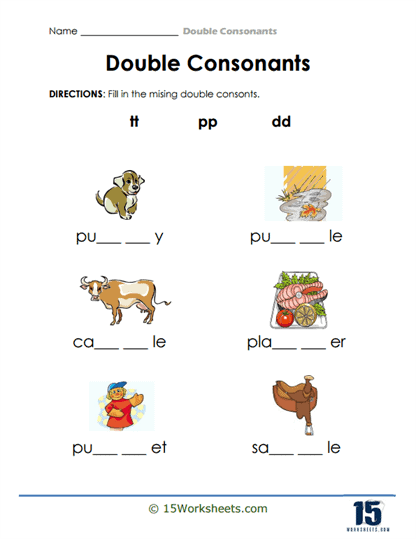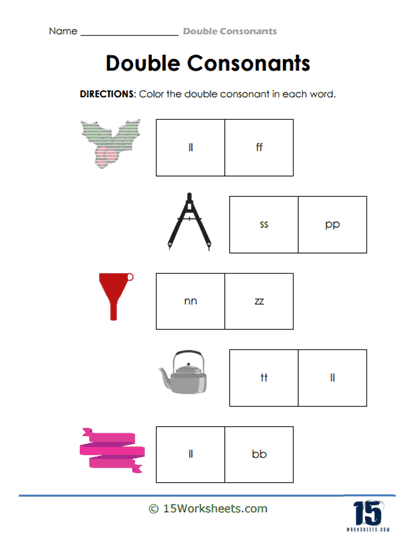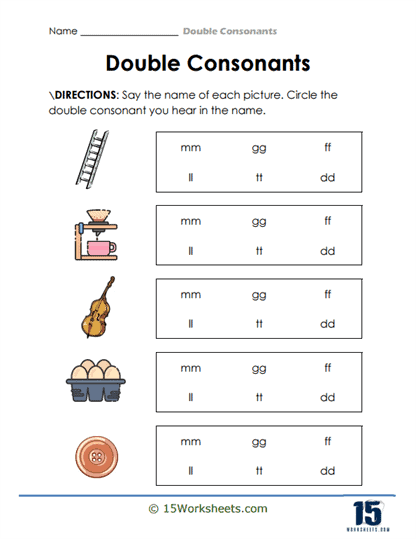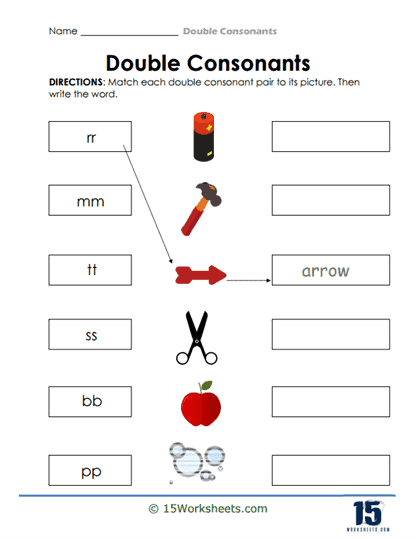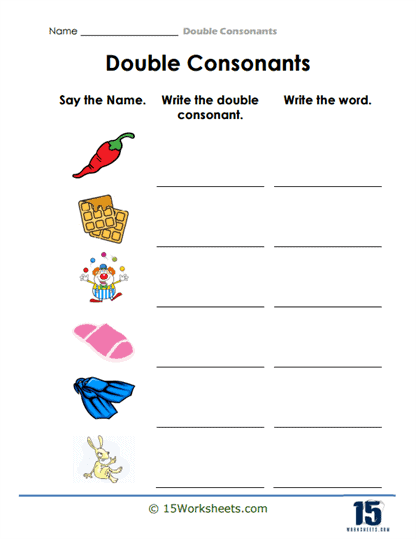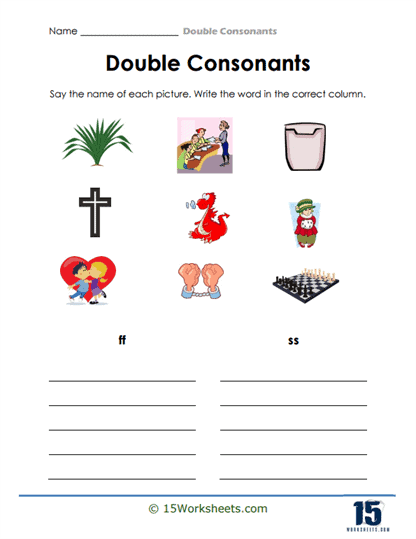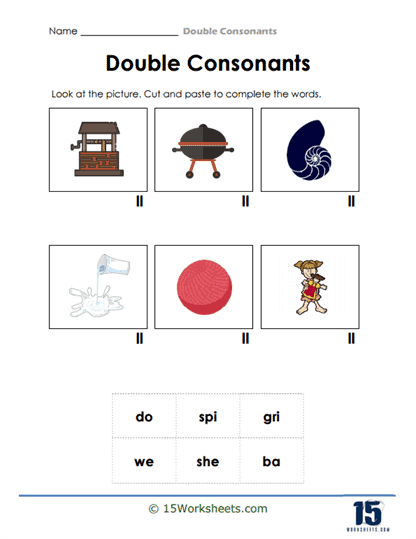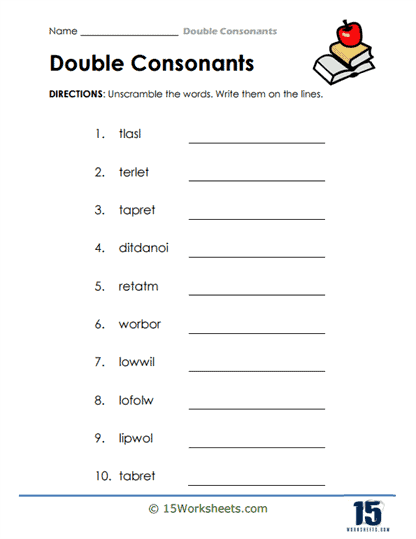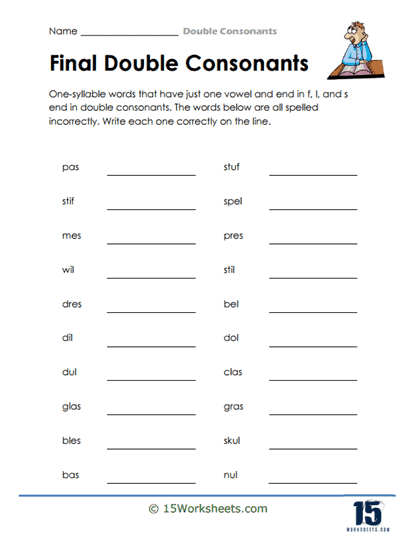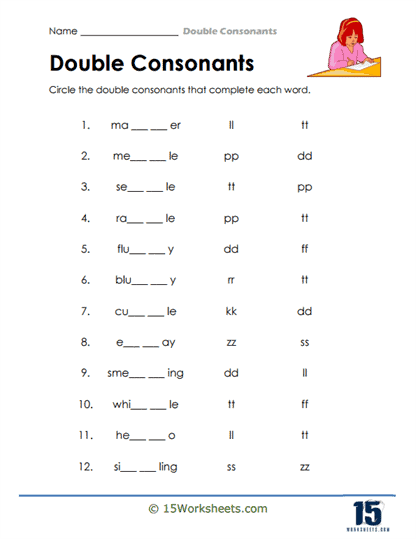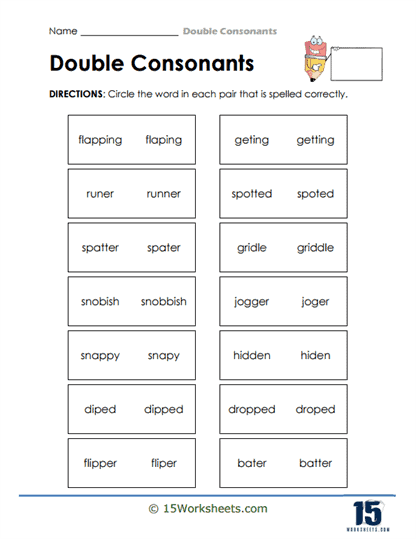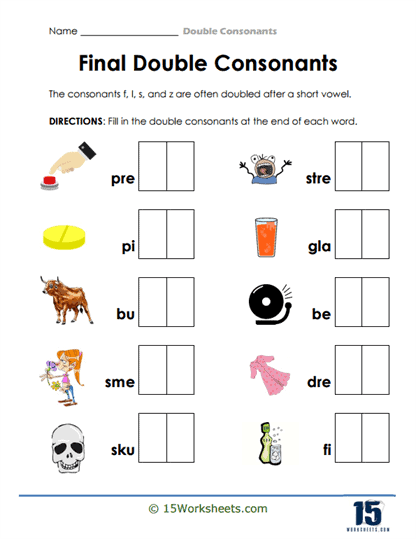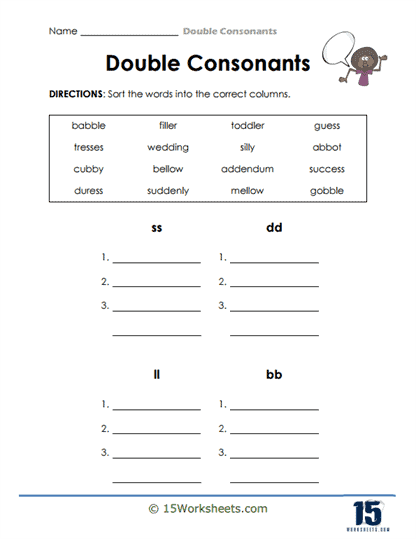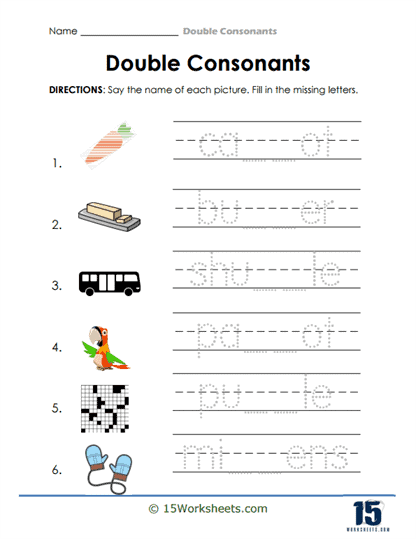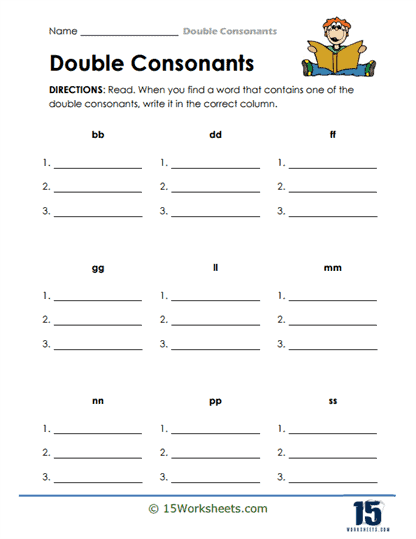Double Consonants Worksheets
About These 15 Worksheets
Introducing our comprehensive collection of Double Consonants Worksheets, designed specifically to enhance students’ understanding and mastery of double consonants in the English language. These worksheets are perfect for teachers, homeschoolers, and parents looking to provide targeted practice that will help students recognize, spell, and correctly pronounce words featuring double consonants.
This series is crafted to support students in developing their phonetic skills, particularly focusing on words with double consonants like “tt,” “pp,” “dd,” and more. Through a variety of engaging and thoughtfully designed activities, students are encouraged to practice the correct usage of these consonants in different word contexts. Each worksheet is available in PDF format, making them easy to download, print, and distribute for individual or classroom use.
A Deep Look At These Worksheets
Through all these worksheets-from detective‑style letter fills to color‑coded sound sorting, punny picture puzzles, and self‑correcting quizzes-students engage with double consonants in ways that are accurate, funny, and deeply thoughtful. They learn to listen, see, write, correct, and reflect-and maybe even ask, “Why on earth do we need two “g”s in ‘eggs’ anyway?” Which, my friend, is exactly the kind of thoughtful pondering we want!
To begin, students dive into the basics with Letter Fill, Consonant Choice, and Consonant Finish. Picture this: a blank line begging for its missing consonant duo-will it be “ll” or “tt”? These worksheets demand careful attention (“Oops-I almost wrote ‘buterfly’ again”). It’s like the student is a detective, staring down the alphabet suspects and interrogating them until the right pair confesses. Meanwhile, Consonant Choice offers multiple options, like a buffet of double‑letter suspects-a thoughtful (and occasionally hilarious) moment of indecision: choose wisely or end up with “chilla” instead of “chilli.”
Next up: auditory awareness. Sound Match, Sound Sort, Color Match, and Correct Match take double consonants on a listening adventure. Students say “hopping,” “mopping,” “popping” aloud, then match or sort sounds-“do I hear the ‘pp’ or the ‘tt’?” Color‑coding raises the bar: “Red for ‘ss’, blue for ‘ll’, and green, because why not?” Guided reflection bubbles under the surface: “Why does ‘jelly’ sound so… jiggly?” This group sharpens the ears, while tickling the funny bone as kids color their way to spelling clarity.
Enter the creative playground: Letter Link, Picture Puzzle, Word Twist, and (a second!) Picture Puzzle. In Letter Link, students chain words by their double‑letter endings (“jelly —> letter —> coffee…”), building a conga line of consonants. The Picture Puzzles pair images with incomplete words-“fi_ _er” next to a necktie photo (yes, “tie” has “tt”). Word Twist ups the ante by scrambling doubles (“llmuchee” → “lumliche?”) until the right word reluctantly emerges. These activities nudge introspection: “Why do those consonants love to stick in the middle?” while also generating delightful comedic frustration.
Time for verification: Spelling Fix, Consonant Quiz, and Sound Sort (again, because some worksheets deserve an encore). Spelling Fix hands students near‑miss words (“happpy”) and dares them to correct the extra consonant or fill in the missing pair. Consonant Quiz reads like academic interrogation, but secretly it’s the final boss battle: “In ‘dinner’, how many ‘n’s?” The double‑dare emerges-every correct answer brings the pride of the diligent speller. These are the moments where deep thought meets laugh‑out‑loud self‑awareness: “I fixed it. I am the spelling wizard.”
Letter Link, Sound Sort, and Correct Match close the loop by blending visual, auditory, and written strategies. Students reflect: “I heard the double out loud, wrote it down twice, matched it to the picture, and colored it in. I am a double‑consonant champion.” It’s thoughtful in that it makes students wonder about language patterns-why does “letter” double the “t”, but “water” doesn’t? These wrap‑up exercises evoke wonder and humor: “Consonants are like best buddies-they don’t want to sit alone!”
With easy access to these PDF worksheets, teachers and parents can provide consistent, targeted practice that will help students become confident and proficient in spelling and reading words with double consonants. Whether you’re introducing the concept for the first time or looking to reinforce existing knowledge, this collection has something to offer for every learner.
What Are Double Consonants Words?
Double consonant words are words in the English language that contain two identical consonant letters placed together. These pairs of consonants can occur in various parts of a word, such as in the middle or at the end, but they are most commonly found after a short vowel sound. Some examples of double consonant words include “apple,” “butter,” “happen,” “dollar,” and “little.” In these instances, the double consonant not only helps define the pronunciation of the word but also serves a critical function in its spelling. Recognizing and understanding double consonants is an essential part of mastering English spelling conventions.
In phonics, double consonants play a significant role in teaching students how to decode and spell words accurately. When a word contains a double consonant, the preceding vowel is typically a short vowel sound. For instance, in the word “supper,” the double “p” indicates that the “u” is pronounced as a short vowel, as opposed to the word “super,” where the single “p” leads to a long vowel sound. This distinction is crucial for young learners as they begin to understand the relationship between vowel sounds and spelling patterns. Teaching students about double consonants helps them develop the ability to predict the correct vowel sound in a word, which is a fundamental skill in reading and writing.
Double consonants also serve as a visual cue for spelling rules in English. One of the most common rules associated with double consonants is the “doubling rule,” which applies when adding a suffix that begins with a vowel (like “-ing” or “-ed”) to a word. For example, in the word “run,” when adding the suffix “-ing” to form “running,” the consonant “n” is doubled. This rule typically applies when the word has a single vowel followed by a single consonant and the accent falls on the last syllable. Understanding this rule helps students avoid common spelling errors and contributes to their overall writing proficiency. It also provides a consistent method for teaching how words change when different suffixes are added.
Recognizing double consonants can significantly impact a student’s reading fluency. Fluency involves the ability to read a text smoothly and accurately, with proper intonation and expression. When students encounter double consonants in words, they use their knowledge of phonics to decode the word correctly, which in turn aids in their comprehension of the text. For example, understanding that the word “hopping” is pronounced with a short “o” and that the “p” is doubled can prevent confusion with the word “hoping,” which has a long “o” sound. This distinction allows students to read more confidently and with better comprehension, as they can quickly and accurately recognize words based on their spelling patterns.

